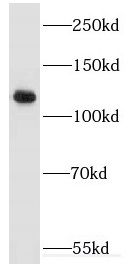Products
EPHA4 antibody
Category:
Research Area:
- SPECIFICATIONS
- Product Name
- EPHA4 antibody
- Catalogue No.
- FNab02802
- Size
- 100μg
- Form
- liquid
- Purification
- Immunogen affinity purified
- Purity
- ≥95% as determined by SDS-PAGE
- Clonality
- polyclonal
- Isotype
- IgG
- Storage
- PBS with 0.02% sodium azide and 50% glycerol pH 7.3, -20℃ for 12 months(Avoid repeated freeze / thaw cycles.)
Immunogen
- Immunogen
- EPH receptor A4
- Alternative Names
- HEK8 antibody, SEK antibody, TYRO1 antibody
- UniProt ID
- P54764
- Observed MW
- 120 kDa
Application
- Tested Applications
- ELISA, WB, IF, IP
- Recommended dilution
- WB: 1:500-1:2000; IP: 1:200-1:1000; IF: 1:20-1:200
Validated Images
 mouse brain tissue were subjected to SDS PAGE followed by western blot with FNab02802(EPHA4 antibody) at dilution of 1:1000
mouse brain tissue were subjected to SDS PAGE followed by western blot with FNab02802(EPHA4 antibody) at dilution of 1:1000
 IP Result of anti-EPHA4 (IP:FNab02802, 4ug; Detection:FNab02802 1:1000) with mouse brain tissue lysate 4000ug.
IP Result of anti-EPHA4 (IP:FNab02802, 4ug; Detection:FNab02802 1:1000) with mouse brain tissue lysate 4000ug.
- Background
- Receptor tyrosine kinase which binds membrane-bound ephrin family ligands residing on adjacent cells, leading to contact-dependent bidirectional signaling into neighboring cells. The signaling pathway downstream of the receptor is referred to as forward signaling while the signaling pathway downstream of the ephrin ligand is referred to as reverse signaling. Highly promiscuous, it has the unique property among Eph receptors to bind and to be physiologically activated by both GPI-anchored ephrin-A and transmembrane ephrin-B ligands including EFNA1 and EFNB3. Upon activation by ephrin ligands, modulates cell morphology and integrin-dependent cell adhesion through regulation of the Rac, Rap and Rho GTPases activity. Plays an important role in the development of the nervous system controlling different steps of axonal guidance including the establishment of the corticospinal projections. May also control the segregation of motor and sensory axons during neuromuscular circuit development. In addition to its role in axonal guidance plays a role in synaptic plasticity. Activated by EFNA1 phosphorylates CDK5 at 'Tyr-15' which in turn phosphorylates NGEF regulating RHOA and dendritic spine morphogenesis. In the nervous system, plays also a role in repair after injury preventing axonal regeneration and in angiogenesis playing a role in central nervous system vascular formation. Additionally, its promiscuity makes it available to participate in a variety of cell-cell signaling regulating for instance the development of the thymic epithelium.



